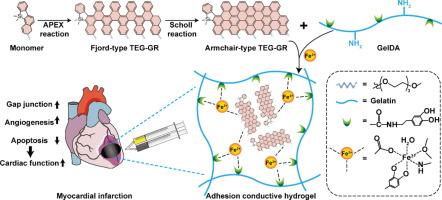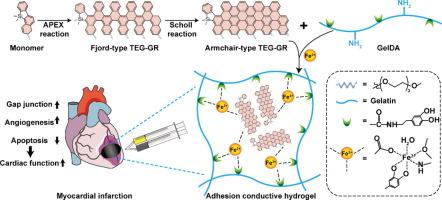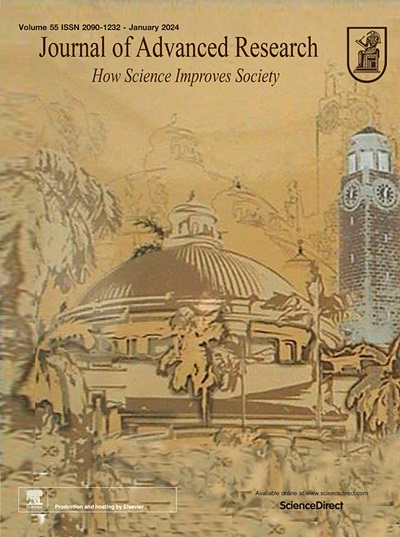Self-adhesion conductive cardiac patch based on methoxytriethylene glycol-functionalized graphene effectively improves cardiac function after myocardial infarction
IF 13
1区 综合性期刊
Q1 MULTIDISCIPLINARY SCIENCES
引用次数: 0
Abstract
Introduction
Abnormal electrical activity of the heart following myocardial infarction (MI) may lead to heart failure or sudden cardiac death. Graphene-based conductive hydrogels can simulate the microenvironment of myocardial tissue and improve cardiac function post-MI. However, existing methods for preparing graphene and its derivatives suffer from drawbacks such as low purity, complex processes, and unclear structures, which limiting their biological applications.
Objectives
We propose an optimized synthetic route for synthesizing methoxytriethylene glycol-functionalized graphene (TEG-GR) with a defined structure. The aim of this study is to establish a novel self-adhesion conductive cardiac patch based on TEG-GR for protecting cardiac function after MI.
Methods
We optimized π-extension polymerization (APEX) reaction to synthesize TEG-GR. TEG-GR was incorporated into dopamine-modified gelatin (GelDA) to construct conductive cardiac patch (TEG-GR/GelDA). We validated the function of TEG-GR/GelDA cardiac patch in rat models of MI, and explored the mechanism of TEG-GR/GelDA cardiac patch by RNA sequencing and molecular biology experiments.
Results
Methoxytriethylene glycol side chain endowed graphene with low immunogenicity and superior biological properties without compromising conductivity. In rats, transplantation of TEG-GR/GelDA cardiac patch onto the infarcted area of heart could more effectively enhance ejection fraction, attenuate collagen deposition, shorten QRS interval and increase vessel density at 28 days post-treatment, compared to non-conductive cardiac patch. Transcriptome analysis indicated that TEG-GR/GelDA cardiac patch could improve cardiac function by maintaining gap junction, promoting angiogenesis, and suppressing cardiomyocytes apoptosis.
Conclusion
The precision synthesis of polymer with defined functional group expands the application of graphene in biomedical field, and the novel cardiac patch can be a promising candidate for treating MI.


基于甲氧基三甘醇功能化石墨烯的自粘性导电心脏贴片可有效改善心肌梗死后的心脏功能
导言心肌梗塞(MI)后心脏电活动异常可能导致心力衰竭或心脏性猝死。基于石墨烯的导电水凝胶可以模拟心肌组织的微环境,改善心肌梗塞后的心脏功能。然而,现有的石墨烯及其衍生物的制备方法存在纯度低、工艺复杂、结构不清晰等缺点,限制了其在生物领域的应用。本研究旨在建立一种基于 TEG-GR 的新型自粘性导电心脏贴片,用于保护心肌梗死后的心脏功能。方法我们优化了π-延伸聚合(APEX)反应来合成 TEG-GR。将 TEG-GR 与多巴胺改性明胶(GelDA)结合,构建导电心脏贴片(TEG-GR/GelDA)。结果甲氧基三甘醇侧链赋予了石墨烯高导电性、低免疫原性和优异的生物特性。与不导电的心脏贴片相比,将 TEG-GR/GelDA 心脏贴片移植到大鼠心肌梗死部位能更有效地提高射血分数,减少胶原沉积,缩短 QRS 间期,并在治疗后 28 天增加血管密度。转录组分析表明,TEG-GR/GelDA 心脏贴片可通过维持间隙连接、促进血管生成和抑制心肌细胞凋亡来改善心脏功能。
本文章由计算机程序翻译,如有差异,请以英文原文为准。
求助全文
约1分钟内获得全文
求助全文
来源期刊

Journal of Advanced Research
Multidisciplinary-Multidisciplinary
CiteScore
21.60
自引率
0.90%
发文量
280
审稿时长
12 weeks
期刊介绍:
Journal of Advanced Research (J. Adv. Res.) is an applied/natural sciences, peer-reviewed journal that focuses on interdisciplinary research. The journal aims to contribute to applied research and knowledge worldwide through the publication of original and high-quality research articles in the fields of Medicine, Pharmaceutical Sciences, Dentistry, Physical Therapy, Veterinary Medicine, and Basic and Biological Sciences.
The following abstracting and indexing services cover the Journal of Advanced Research: PubMed/Medline, Essential Science Indicators, Web of Science, Scopus, PubMed Central, PubMed, Science Citation Index Expanded, Directory of Open Access Journals (DOAJ), and INSPEC.
 求助内容:
求助内容: 应助结果提醒方式:
应助结果提醒方式:


